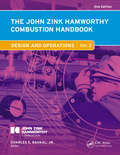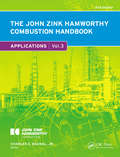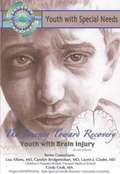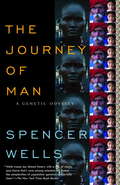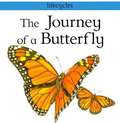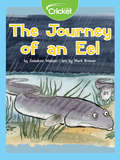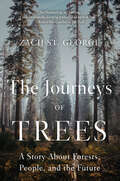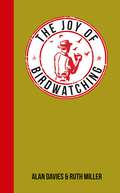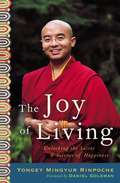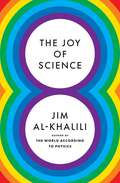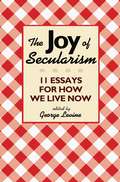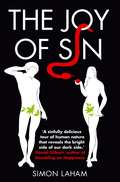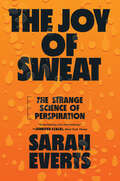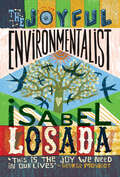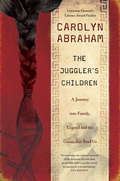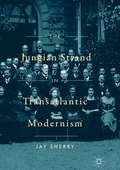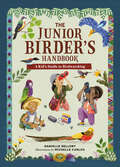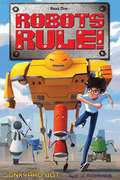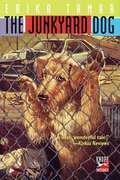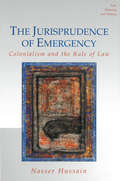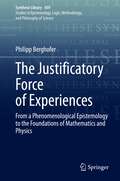- Table View
- List View
The John Zink Hamworthy Combustion Handbook: Volume 2 Design and Operations (Industrial Combustion)
by Charles E. Baukal.Despite the length of time it has been around, its importance, and vast amounts of research, combustion is still far from being completely understood. Issues regarding the environment, cost, and fuel consumption add further complexity, particularly in the process and power generation industries. Dedicated to advancing the art and science of industr
The John Zink Hamworthy Combustion Handbook: Volume 3 Applications (Industrial Combustion)
by Charles E. BaukalDespite the length of time it has been around, its importance, and vast amounts of research, combustion is still far from being completely understood. Issues regarding the environment, cost, and fuel consumption add further complexity, particularly in the process and power generation industries. Dedicated to advancing the art and science of industr
The Journey Toward Recovery: Youth with Brain Injury (Youth with Special Needs)
by Joan EsherickJerome pedaled down the mountain, his friends Tommy and Eric racing to catch up. The wide, flat path was made for smooth riding, but Jerome's mind wasn't on the trail. A sudden rustling in the brush ahead startled him out of his daydreaming. A dog darted out of the shrubs, then stopped dead in the trail. The next several seconds seemed to pass in slow motion. Jerome squeezed hard on the hand brakes, but it was too late. His front wheel collided with the animal; the dog yelped; and Jerome somersaulted over his handlebars. Tommy said later he would never forget how his friend flew through the air and collided head-on with the sycamore tree. Eric said he'd never forget the sickening thud the impact made. But what his friends would never forget, Jerome would never remember. In a brilliant white flash, Jerome's life as he knew it was gone. What do bikes, cars, scooters, sports, tumors, strokes, guns, and the shaking of babies all have in common? They all can cause brain injuries. Every twenty-one seconds, one person in the United States sustains a traumatic brain injury. In The Journey Toward Recovery: Youth with Brain Injury you will read about Jerome, one teen who finds his life changed forever in a split-second accident. Along the way, you will also learn about other forms of brain injury; how these injuries affect people's lives; and how schools, doctors, and lawmakers are helping youth with this form of special need.
The Journey of Man: A Genetic Odyssey
by Spencer WellsAround 60,000 years ago, a man--genetically identical to us--lived in Africa. Every person alive today is descended from him. How did this real-life Adam wind up as the father of us all? What happened to the descendants of other men who lived at the same time? And why, if modern humans share a single prehistoric ancestor, do we come in so many sizes, shapes, and races?<P> Examining the hidden secrets of human evolution in our genetic code, Spencer Wells reveals how developments in the revolutionary science of population genetics have made it possible to create a family tree for the whole of humanity. Replete with marvelous anecdotes and remarkable information, from the truth about the real Adam and Eve to the way differing racial types emerged, The Journey of Man is an enthralling, epic tour through the history and development of early humankind.
The Journey of Man: A Genetic Odyssey
by Spencer WellsAround 60,000 years ago, a man—genetically identical to us—lived in Africa. Every person alive today is descended from him. How did this real-life Adam wind up as the father of us all? What happened to the descendants of other men who lived at the same time? And why, if modern humans share a single prehistoric ancestor, do we come in so many sizes, shapes, and races?Examining the hidden secrets of human evolution in our genetic code, Spencer Wells reveals how developments in the revolutionary science of population genetics have made it possible to create a family tree for the whole of humanity. Replete with marvelous anecdotes and remarkable information, from the truth about the real Adam and Eve to the way differing racial types emerged, The Journey of Man is an enthralling, epic tour through the history and development of early humankind.
The Journey of Man: A Genetic Odyssey
by Spencer WellsAround 60,000 years ago, a man—genetically identical to us—lived in Africa. Every person alive today is descended from him. How did this real-life Adam wind up as the father of us all? What happened to the descendants of other men who lived at the same time? And why, if modern humans share a single prehistoric ancestor, do we come in so many sizes, shapes, and races?Examining the hidden secrets of human evolution in our genetic code, Spencer Wells reveals how developments in the revolutionary science of population genetics have made it possible to create a family tree for the whole of humanity. Replete with marvelous anecdotes and remarkable information, from the truth about the real Adam and Eve to the way differing racial types emerged, The Journey of Man is an enthralling, epic tour through the history and development of early humankind.
The Journey of a Butterfly (Lifecycles)
by Carolyn ScraceDescribes the life cycle and annual migration of the monarch butterfly.
The Journey of an Eel
by Galadriel WatsonThe freshwater eel is a fish that makes two remarkable journeys, one at the beginning of its life, and another at the end. It is born in the ocean, lives its adult life in a freshwater stream, then returns to the ocean.
The Journeys of Trees: A Story About Forests, People, And The Future
by Zach St. GeorgeAn urgent and illuminating portrait of forest migration, and of the people studying the forests of the past, protecting the forests of the present, and planting the forests of the future. Forests are restless. Any time a tree dies or a new one sprouts, the forest that includes it has shifted. When new trees sprout in the same direction, the whole forest begins to migrate, sometimes at astonishing rates. Today, however, an array of obstacles—humans felling trees by the billions, invasive pests transported through global trade—threaten to overwhelm these vital movements. Worst of all, the climate is changing faster than ever before, and forests are struggling to keep up. A deft blend of science reporting and travel writing, The Journeys of Trees explores the evolving movements of forests by focusing on five trees: giant sequoia, ash, black spruce, Florida torreya, and Monterey pine. Journalist Zach St. George visits these trees in forests across continents, finding sequoias losing their needles in California, fossil records showing the paths of ancient forests in Alaska, domesticated pines in New Zealand, and tender new sprouts of blight-resistant American chestnuts in New Hampshire. Everywhere he goes, St. George meets lively people on conservation’s front lines, from an ecologist studying droughts to an evolutionary evangelist with plans to save a dying species. He treks through the woods with activists, biologists, and foresters, each with their own role to play in the fight for the uncertain future of our environment. An eye-opening investigation into forest migration past and present, The Journeys of Trees examines how we can all help our trees, and our planet, survive and thrive.
The Joy of Birdwatching: For Those Who Love Seeing Birds in the Wild
by Alan Davies Ruth MillerThis pocket-sized miscellany, packed with fascinating facts, handy hints and captivating stories and quotes from the world of birds, is perfect for anyone who knows the incomparable joy of birdwatching.
The Joy of Birdwatching: For Those Who Love Seeing Birds in the Wild
by Alan Davies Ruth MillerThis pocket-sized miscellany, packed with fascinating facts, handy hints and captivating stories and quotes from the world of birds, is perfect for anyone who knows the incomparable joy of birdwatching.
The Joy of Living: Unlocking the Secret and Science of Happiness
by Daniel Goleman Eric Swanson Yongey MingyurFor millennia, Buddhists have enjoyed the limitless benefits of meditation. But how does it work? And why? The principles behind this ancient practice have long eluded some of the best minds in modern science. Until now.In this groundbreaking work, world-renowned Buddhist teacher Yongey Mingyur Rinpoche invites us to join him in unlocking the secrets behind the practice of meditation. Working with neuroscientists at the Waisman Laboratory for Brain Imaging and Behavior, Yongey Mingyur provides clear insights into modern research indicating that systematic training in meditation can enhance activity in areas of the brain associated with happiness and compassion. He has also worked with physicists across the country to develop a fresh, scientifically based interpretation of the Buddhist understanding of the nature of reality.With an infectious joy and insatiable curiosity, Yongey Mingyur weaves together the principles of Tibetan Buddhism, neuroscience, and quantum physics in a way that will forever change the way we understand the human experience. Using the basic meditation practices he provides, we can discover paths through everyday problems, transforming obstacles into opportunities to recognize the unlimited potential of our own minds.With a foreword by bestselling author Daniel Goleman, The Joy of Living is a stunning breakthrough, an illuminating vision of the science of Buddhism and a handbook for transforming our minds, bodies, and lives.From the Hardcover edition.
The Joy of Science
by Roel Snieder Jen SchneiderWe live in an age where working in science or engineering offers tremendous professional opportunities - the pace of scientific development is truly breathtaking. Yet many researchers struggle with the pressures of the fast-paced academic workplace, and struggle to harmonize their work and personal lives. The result can be burnout, exhaustion, and stress on a personal level, and difficulty in recruiting and retaining talented, diverse people to science and engineering. This book, written for graduate students and researchers at all stages of their careers, aims to help scientists by identifying and questioning the core beliefs that drive a culture of overwork, and provides real-world examples and exercises for those wishing to do things differently. Written in a lively narrative style, and including interview excerpts from practicing scientists, social scientists, and engineers, this book serves as a guide for those seeking to practice the seven traits of the joyful scientist.
The Joy of Science
by Jim Al-KhaliliQuantum physicist, New York Times bestselling author, and BBC host Jim Al-Khalili reveals how 8 lessons from the heart of science can help you get the most out of lifeToday’s world is unpredictable and full of contradictions, and navigating its complexities while trying to make the best decisions is far from easy. The Joy of Science presents 8 short lessons on how to unlock the clarity, empowerment, and joy of thinking and living a little more scientifically.In this brief guide to leading a more rational life, acclaimed physicist Jim Al-Khalili invites readers to engage with the world as scientists have been trained to do. The scientific method has served humankind well in its quest to see things as they really are, and underpinning the scientific method are core principles that can help us all navigate modern life more confidently. Discussing the nature of truth and uncertainty, the role of doubt, the pros and cons of simplification, the value of guarding against bias, the importance of evidence-based thinking, and more, Al-Khalili shows how the powerful ideas at the heart of the scientific method are deeply relevant to the complicated times we live in and the difficult choices we make.Read this book and discover the joy of science. It will empower you to think more objectively, see through the fog of your own preexisting beliefs, and lead a more fulfilling life.
The Joy of Secularism: 11 Essays for How We Live Now
by George LevineCan secularism offer us moral, aesthetic, and spiritual satisfaction? Or does the secular view simply affirm a dog-eat-dog universe? At a time when the issues of religion, evolution, atheism, fundamentalism, Darwin, and science fill headlines and invoke controversy, The Joy of Secularism provides a balanced and thoughtful approach for understanding an enlightened, sympathetic, and relevant secularism for our lives today. Bringing together distinguished historians, philosophers, scientists, and writers, this book shows that secularism is not a mere denial of religion. Rather, this positive and necessary condition presents a vision of a natural and difficult world--without miracles or supernatural interventions--that is far richer and more satisfying than the religious one beyond. From various perspectives--philosophy, evolutionary biology, primate study, Darwinian thinking, poetry, and even bird-watching--the essays in this collection examine the wealth of possibilities that secularism offers for achieving a condition of fullness. Factoring in historical contexts, and ethical and emotional challenges, the contributors make an honest and heartfelt yet rigorous case for the secular view by focusing attention on aspects of ordinary life normally associated with religion, such as the desire for meaning, justice, spirituality, and wonder. Demonstrating that a world of secular enchantment is a place worth living in, The Joy of Secularism takes a new and liberating look at a valuable and complex subject. The contributors are William Connolly, Paolo Costa, Frans de Waal, Philip Kitcher, George Levine, Adam Phillips, Robert Richards, Bruce Robbins, Rebecca Stott, Charles Taylor, and David Sloan Wilson.
The Joy of Sin: The Psychology of the Seven Deadly Sins
by Simon LahamUsing modern psychological science, a great deal of research, historical anecdotes and an eloquent turn of phrase, the author contends that the 'seven deadly sins' not only feel good, but are also good for you. From gluttony to greed, to envy and lust, even the deadliest of sins can make you smart, successful and happy. For example, anger can breed perseverance, sloth: hopefulness, greed: happiness and envy can actually bolster one's self-esteem. Based on many studies, the author tells us why the greedy are happy, the slothful are smart, gluttons are social butterflies and how anger can make you a fearsome negotiator.The simplistic labelling of the seven deadly sins as 'sins' or as uniformly wrong does nothing but breed contempt for 'sinners' and stifle sophisticated discussion. Sin rails against this simplicity. Each chapter will cover an array of fascinating psychological research that demonstrates just how interesting and complex the seven deadly sins are. So the basic message of Sin: relax, spend, eat, drink and generally covet - you'll be better off for it.
The Joy of Sweat: The Strange Science Of Perspiration
by Sarah EvertsA New York Times Most Anticipated Book of the Summer A taboo-busting romp through the shame, stink, and strange science of sweating. Sweating may be one of our weirdest biological functions, but it’s also one of our most vital and least understood. In The Joy of Sweat, Sarah Everts delves into its role in the body—and in human history. Why is sweat salty? Why do we sweat when stressed? Why do some people produce colorful sweat? And should you worry about Big Brother tracking the hundreds of molecules that leak out in your sweat—not just the stinky ones or alleged pheromones—but the ones that reveal secrets about your health and vices? Everts’s entertaining investigation takes readers around the world—from Moscow, where she participates in a dating event in which people sniff sweat in search of love, to New Jersey, where companies hire trained armpit sniffers to assess the efficacy of their anti-sweat products. In Finland, Everts explores the delights of the legendary smoke sauna and the purported health benefits of good sweat, while in the Netherlands she slips into the sauna theater scene, replete with costumes, special effects, and towel dancing. Along the way, Everts traces humanity’s long quest to control sweat, culminating in the multibillion-dollar industry for deodorants and antiperspirants. And she shows that while sweating can be annoying, our sophisticated temperature control strategy is one of humanity’s most powerful biological traits. Deeply researched and written with great zest, The Joy of Sweat is a fresh take on a gross but engrossing fact of human life.
The Joyful Environmentalist (Revised and Updated 2nd Edition with New Material): How to Practise without Preaching
by Isabel LosadaFully updated and revised edition of Isabel Losada's highly endorsed, feel good guide to how we all need to live now and how it will enrich our lives. Accessible, funny and practical steps to saving the planet that will encourage readers to take action.Finally! A book about saving our planet that is fast, funny and inspiring too. Written in short chapters for busy people, Isabel doesn&’t bother with an examination of the problem but gets right on with the solutions. Her aim: to look for every single way we can take care of the planet; how we live and work, travel, shop, eat, drink, dress, vote, play, volunteer, bank – everything. And to do this wholeheartedly, energetically and joyfully.Beginning with losing her cool in a restaurant that will only provide plastic cutlery, Isabel journeys through native tree planting in the Highlands of Scotland, playing Samba drums with Extinction Rebellion, interviewing in person the people that supply her energy and food – through every solution she can find – until both narrator and reader are fully equipped to be part of the pollution solution."She gave my spirit a lift and my feet somewhere to stand." – Sir Mark Rylance
The Juggler's Children
by Carolyn AbrahamCarolyn Abraham explores the stunning power and ethical pitfalls of using genetic tests to answer questions of genealogy--by cracking the genome of her own family. Recently, tens of thousands of people have been drawn to mail-order DNA tests to learn about their family roots. Abraham investigates whether this burgeoning new science can help solve 2 mysteries that have haunted her multi-racial family for more than a century. Both hinge on her enigmatic great-grandfathers--a hero who died young and a scoundrel who disappeared. Can the DNA they left behind reveal their stories from beyond the grave? Armed with DNA kits, Abraham criss-crosses the globe, taking cells from relatives and strangers, a genetic journey that turns up far more than she bargained for--ugly truths and moral quandaries. With lively writing and a compelling personal narrative, The Juggler's Children tackles profound questions around the genetics of identity, race and humanity, and tells a big story about our small world, with vivid proof that genes bind us all to the branches of one family tree.From the Hardcover edition.
The Jungian Strand in Transatlantic Modernism
by Jay SherryIn studies of psychology’s role in modernism, Carl Jung is usually relegated to a cameo appearance, if he appears at all. This book rethinks his place in modernist culture during its formative years, mapping Jung’s influence on a surprisingly vast transatlantic network of artists, writers, and thinkers. Jay Sherry sheds light on how this network grew and how Jung applied his unique view of the image-making capacity of the psyche to interpret such modernist icons as James Joyce and Pablo Picasso. His ambition to bridge the divide between the natural and human sciences resulted in a body of work that attracted a cohort of feminists and progressives involved in modern art, early childhood education, dance, and theater.
The Junior Birder's Handbook: A Kid's Guide to Birdwatching (The Junior Handbook Series)
by Danielle BellenyA beautifully illustrated kid's guide to birds and their habitats, perfect for budding birders whether you live in a city, suburb, or rural area. In the woods, in cities, in your backyard—birds are everywhere. But do you know the difference between a robin and a wren? A raven and a crow? In this fully illustrated book, you will learn how to identify birds in an array of habitats and seasons (thanks to migration, there are always new birds to find). You'll also learn the different behaviors/habits of birds—from why blue jays divebomb other birds&’ nests to what attracts hummingbirds to certain flowers. As the popularity of birding and birdwatching reach new heights, more and more children have the opportunity to connect with nature, whether indoors or outside and with no equipment other than one&’s eyes (and this handbook, of course). What&’s not to love? Featuring Michelle Carlos's vibrant illustrations, this gorgeous (and gifty) book includes interactive elements like quizzes and crafts, as well as accessible charts/guides that will lead to endless fun!
The Junkyard Bot
by Goro Fujita C. J. RichardsWorker robots keep the high-tech town of Terabyte Heights humming, but ten-year-old George Gearing is the only one who has a robot for a best friend. When his scrappy but beloved pal Jackbot is hit by a car, the whiz kid re-engineers him with fancy parts from state-of-the-art TinkerTech Laboratories. Jackbot's astounding new skills far exceed anything George--or even TinkerTech's head of robotics--could ever have imagined. Will the villainous Dr. Micron destroy the whole town to see his tech-driven dream realized? Not if George can help it . . .
The Jurisprudence of Emergency
by Nasser HussainHussain analyses the uses and the history of a range of emergency powers, such as the suspension of habeas corpus and the use of military tribunals. His study focuses on British colonialism in India from the late eighteenth to the early twentieth century to demonstrate how questions of law and emergency shaped colonial rule, which in turn affected the place of colonialism in modern law, depicting the colonies not as passive recipients but as agents in the interpretation and delineation of Western ideas and practices. Nasser Hussain is Professor of History at Amherst College.
The Justificatory Force of Experiences: From a Phenomenological Epistemology to the Foundations of Mathematics and Physics (Synthese Library #459)
by Philipp BerghoferThis book offers a phenomenological conception of experiential justification that seeks to clarify why certain experiences are a source of immediate justification and what role experiences play in gaining (scientific) knowledge. Based on the author's account of experiential justification, this book exemplifies how a phenomenological experience-first epistemology can epistemically ground the individual sciences. More precisely, it delivers a comprehensive picture of how we get from epistemology to the foundations of mathematics and physics.The book is unique as it utilizes methods and insights from the phenomenological tradition in order to make progress in current analytic epistemology. It serves as a starting point for re-evaluating the relevance of Husserlian phenomenology to current analytic epistemology and making an important step towards paving the way for future mutually beneficial discussions. This is achieved by exemplifying how current debates can benefit from ideas, insights, and methods we find in the phenomenological tradition.
